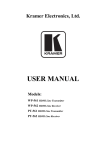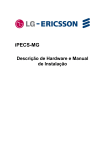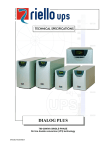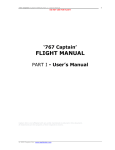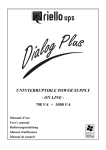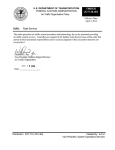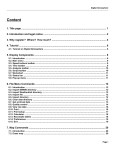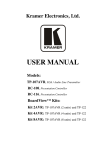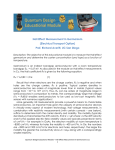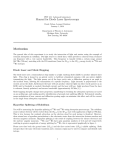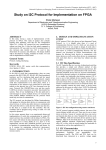Download final report - Ministry of Transport
Transcript
FINAL REPORT BOEING 777-300, REGISTRATION 9V-SYH TURBULENCE ENCOUNTER 17 OCTOBER 2011 AIB/AAI/CAS.078 Air Accident Investigation Bureau of Singapore Ministry of Transport Singapore 14 May 2013 © 2013 Government of Singapore 1 The Air Accident Investigation Bureau of Singapore The Air Accident Investigation Bureau (AAIB) is the air accidents and incidents investigation authority in Singapore responsible to the Ministry of Transport. Its mission is to promote aviation safety through the conduct of independent and objective investigations into air accidents and incidents. The AAIB conducts the investigations in accordance with the Singapore Air Navigation (Investigation of Accidents and Incidents) Order 2003 and Annex 13 to the Convention on International Civil Aviation, which governs how member States of the International Civil Aviation Organization (ICAO) conduct aircraft accident investigations internationally. In carrying out the investigations, the AAIB will adhere to ICAO’s stated objective, which is as follows: “The sole objective of the investigation of an accident or incident shall be the prevention of accidents and incidents. It is not the purpose of this activity to apportion blame or liability.” Accordingly, it is inappropriate that AAIB reports should be used to assign fault or blame or determine liability, since neither the investigation nor the reporting process has been undertaken for that purpose. © 2013 Government of Singapore 2 Contents GLOSSARY OF ABBREVIATION ................................................................................ 4 SYNOPSIS ....................................................................................................................... 5 AIRCRAFT DETAILS .................................................................................................... 5 1 FACTUAL INFORMATION ................................................................................... 6 1.1 History of the flight ........................................................................................... 6 1.2 Injuries to persons .............................................................................................. 8 1.3 Personnel information........................................................................................ 9 1.4 Weather radar .................................................................................................... 9 1.5 Flight recorders ................................................................................................ 11 1.6 Additional Information .................................................................................... 11 2 DISCUSSION ......................................................................................................... 14 3 SAFETY ACTION.................................................................................................. 16 4 SAFETY RECOMMENDATIONS ........................................................................ 16 © 2013 Government of Singapore 3 GLOSSARY OF ABBREVIATION ACARS ATC CIC CVR FDR fpm ft FO MSL ND nm PANS-ATM PF PFD PIC PIREP PNF QAR QNH SFO Aircraft Communications Addressing and Reporting System Air Traffic Control Cabin Crew-in-charge Cockpit Voice Recorder Flight Data Recorder Feet per minute Feet First Officer Mean sea level Navigation Display Nautical miles Procedure for Air Navigation Services - Air Traffic Management Pilot Flying Primary Flight Display Pilot-in-command Pilot Report Pilot not flying Quick Access Recorder Altitude above mean sea level based on local station pressure Senior First Officer SIGMET Significant Meteorological Information SO UTC Second Officer Universal Time Coordinate © 2013 Government of Singapore 4 SYNOPSIS On 17 October 2011, the pilots of a Boeing B777-300 aircraft, which was cruising at 35,000 feet (ft) on a scheduled flight from Shanghai to Singapore, observed on their weather radar some clouds ahead in their flight path. The pilots requested permission from the Air Traffic Control (ATC) to deviate to the left of their flight path to avoid the clouds. The aircraft was flying clear of the clouds during the deviation and as the flight was smooth, the pilots did not switch on the seat belt sign. When the aircraft was about four and a half nautical miles (nm) from the weather clouds, it experienced sudden turbulence and the aircraft lost about 100 ft in altitude. The turbulence lasted for about 8 seconds and subsequently the flight was smooth again. The aircraft landed without further incident. Sixteen passengers and five cabin crew members were injured as a result of the turbulence. All injuries were minor except for a simple fracture of a rib suffered by one passenger. The Air Accident investigation Bureau of Singapore classified this occurrence as an accident in accordance with the Air Navigation (Investigation of Accidents and Incidents) Order and instituted an investigation. AIRCRAFT DETAILS Aircraft type Operator Aircraft registration Numbers and type of engines Type of flight Persons on board © 2013 Government of Singapore : Boeing B777-300 : Singapore Airlines : 9V-SYH : 2 x Rolls Royce Trent 800 : Scheduled passenger flight : 205 5 1 FACTUAL INFORMATION Unless otherwise stated, all times quoted in this report are based on Singapore local time, which is 8 hours ahead of Coordinated Universal Time (UTC). 1.1 History of the flight 1.1.1 The aircraft, a Boeing B777-300, was operating from Shanghai to Singapore on 17 October 2011. The Senior First Officer (SFO), who was on command training, occupied the left seat in the cockpit and was the pilot flying (PF). The Pilot-in-command (PIC), who was a Line Instructor Pilot, occupied the right seat and was the Pilot Monitoring (PM). Another First Officer acting as a safety officer occupied the observer seat behind the two pilots. 1.1.2 A pre-flight briefing was conducted by the PIC. Based on the Significant Meteorological Information (SIGMET), the PIC advised the Cabin Crew incharge (CIC) to expect turbulence one hour into the flight and that the turbulence would last for two hours. For weather detection, the aircraft was equipped with Honeywell RDR 4B weather radar system with manual and auto radar antenna tilt angle selection1. 1.1.3 About 3 hours into the flight, the aircraft was cruising at 35,000 ft about 80 nm from waypoint KARAN. The aircraft was on autopilot flying along the airway L642, and the antenna tilt control of the weather radar was in the automatic mode. The PIC’s and SFO’s Navigational Display (ND) was set at a range of 160 nm and 80 nm respectively2. The SFO noticed a green dot on his ND, which suggested a weather cell ahead3. The weather cell was about 5 nm in diameter and the track of the aircraft would pass by the left edge of the cell (Figure 1). 1.1.4 The SFO switched the radar tilt control to manual mode and manipulated the weather radar antenna tilt angle between 0° to -2° to better assess the weather cell. At 60 nm from the weather cell, the PIC requested for and was given an ATC clearance to deviate 10 nm to the left of the aircraft’s current track and upwind of the weather cell. The final assessment was 1 Some of the operator’s B777 was equipped with RDR 4B with only manual radar antenna tilt angle selection. It is the operator’s practice that the range of PM’s ND is always set to one range higher than that of PF’s ND. 3 The weather returns captured by the aircraft’s weather radar system is displayed on the Navigational Display. The returns are colour-coded in accordance with the intensity of the return which is proportional to the amount of precipitation. 2 Colour Black Green Yellow Red Magenta Return strength Very light or no returns Light returns Medium returns Strong returns Turbulence © 2013 Government of Singapore Rainfall rate Less than 0.7 mm/hr 0.7 - 4 mm/hr 4 – 12 mm/hr Greater than 12 mm/hr N/A 6 made with PIC’s and SFO’s range setting selected to 80 nm and 40 nm respectively. The weather cell was still displaying green. At 40 nm from the weather cell, the SFO selected a heading change of about 11° to the left of the track (to bring the aircraft to a heading of about 210°) and started the deviation. Figure 1: Illustration of flight path (not to scale) 1.1.5 Two and a half minutes later, the SFO selected a heading and turned the aircraft back to a track that was parallel with the original track. From the ND, the SFO estimated that the deviation was 5 to 7 nm to the left of the original track. From the GPS coordinates recorded in the Flight Data Recorder (FDR), the deviation track was deduced to be 4.5 nm left of the original track. 1.1.6 According to the PIC, the weather outside was clear and he could see the lights on land as well as the lights of the boats along the coast. He was also able to see the silhouette of the weather cell. Considering that the flight was smooth and the aircraft was flying well clear of the weather cell, the flight crew did not see the need to switch on the seat belt sign or reduce the aircraft speed to the turbulence penetration speed4 (Mach 0.82). 1.1.7 As the aircraft was abeam of the weather cell, the SFO noticed some light radar returns (shown as green returns in the form of short fine lines) directly in front of the aircraft symbol on his ND. He turned on the landing lights and saw some very light traces of cloud, and so he immediately initiated a turn of 20° to the left to bring the aircraft further away from the 4 Turbulence penetration speed – speed recommended by manufacturer when flying through turbulence to minimise structural damage to aircraft. © 2013 Government of Singapore 7 weather cell. 1.1.8 The aircraft was in a left bank of about 9° when it began to experience turbulence. He immediately switched on the seat belt sign and slowed the aircraft from Mach 0.83 to 0.82, but the aircraft still experienced severe turbulence that lasted for about eight seconds, resulting in injuries to 21 persons on board. 1.1.9 FDR data showed that the aircraft was subjected to fluctuating vertical accelerations between 1.66 g and -0.27 g with recorded vertical speeds of between +800 and -1,336 feet per minute (fpm). 1.1.10 The remaining of the flight after this turbulence encounter was smooth and the aircraft landed in Singapore without further event. 1.2 Injuries to persons 1.2.1 The breakdown of the 21 injuries is as shown in the table below. Injuries Fatal Serious Minor None Total Flight 3 3 Cabin crew 5 10 15 Passengers 1* 15 171 187 Total 1 20 184 205 *Rib fracture 1.2.2 A doctor who was on board assisted the crew in attending to four of the more serious injuries. He advised that the conditions of these four had stabilised but would require further medical attention on arrival in Singapore. Basing on this advice, the PIC did not consider it necessary to declare a medical emergency to ATC and chose to continue the flight to Singapore which was only an hour away. 1.2.3 The PIC made arrangements for medical assistance to stand by for the aircraft in Singapore. The flight crew was busy coordinating with the cabin crew on the handling of the injured and did not inform ATC of the turbulence encounter5. 1.2.4 All the injuries occurred at the back of the aircraft in the economy class. One injured passenger was in his seat but did not have his seat belt fastened. Another injured passenger was getting out of his aisle seat to allow another passenger to get into her seat after returning from the lavatory. The rest of the injured passengers were not at their seat during the turbulence encounter. Most of them were waiting to use the lavatory. 5 A Technical Crew Circular of the operator on prevention of turbulence related injuries reminds flight crews to issue a Pilot Report (PIREP) to inform ATC or other aircraft in the vicinity when turbulence is encountered. © 2013 Government of Singapore 8 1.3 Personnel information Gender Age Last base check Last line Check Total flying experience Total on B777 Flying in last 24 hours Flying in last 7 days Flying in last 90 days PIC Male 43 14 September 2011 11 April 2011 11580 hrs 4751 hrs 10 hrs 14 min 13 hrs 28 min 237 hrs 30 min SFO Male 40 16 September 2011 1 October 2011 5813 hrs 1842 hrs Nil 10 hrs 14 min 79 hrs FO (Safety Pilot) Male 31 12 October 2011 10 June 2011 912 hrs 45 min 872 hrs Nil 10 hrs 14 min 174 hrs 1 min 1.4 Weather radar 1.4.1 The aircraft’s radar system is to provide weather avoidance with turbulence detection, windshear detection and terrain mapping modes of operation. The operator had the following weather radar system variants in its B777 fleet: 1.4.2 Aircraft variant B777-200 B777-200ER B777-300 Weather radar system variant Honeywell RDR 4B (Some with manual/auto radar antenna tilt angle selection*, some with just manual selection) B777-300ER Honeywell RDR 4000 * Variant on the incident aircraft The intensity of the reflection of the radar wave by the weather cell depends on the content of the weather cell. Water droplets and wet hail provide very good reflection while dry hail, ice crystal and snow do not reflect radar waves well. In a column of thunderstorm cloud, the freezing altitude where super-cooled water is transformed to ice is about 20,000 ft. A radar beam that is tilted to scan the region above this freezing altitude would most likely be scanning ice crystal that has poor reflectivity and the resulting display on the ND may not reflect the true nature of the weather cell. © 2013 Government of Singapore 9 Figure 2: Illustration of antenna tilt angle and reflective zone of precipitation 1.4.3 When the antenna is tilted downwards, and depending on the altitude of the aircraft, the radar system could also pick up radar reflections from the ground. Depending on the range set on the ND, such ground returns would clutter the ND and the flight crew would need to be able to differentiate between ground and weather returns shown on the ND. 1.4.4 The operator has required all flight crew to undergo computer-based training on how to operate the weather radar system during their initial aircraft type qualification. The flight simulator training programme contains a discussion item on the use of weather radar and flight crews are assessed on their proficiency in using the weather radar to analyse and avoid a thunderstorm in the simulator. As part of their line training, flight crews learn to operate the weather radar system during their actual flights and are required to demonstrate their proficiency in weather detection and avoidance before being assessed as competent by instructor pilots. 1.4.5 The operator has also made available on its intranet the weather radar manufacturer’s literature on the use of weather radar and required its flight crews to log on to its intranet to read them. According to its flight crew training department, flight crews were taught the techniques of operating the weather radar in accordance with the manufacturer’s user manual. 1.4.6 The three pilots on the incident aircraft had logged on to the intranet to review the literature on the use of weather radar. 1.4.7 RDR 4B radar system 1.4.7.1 There are two variants for the RDR 4B radar system: • RDR 4B with manual/auto antenna tilt function • RDR 4B with only manual antenna tilt function © 2013 Government of Singapore 10 Both variants have basically the same capability. However, for the variant with only manual antenna tilt function, the flight crew will need to manipulate the antenna tilt angle to try to find an optimum in-flight angle (i.e. an angle that produces the least ground clutter while maintaining good weather detection capability)6, whereas for the variant with manual/auto tilt function, the optimum tilt angle for the radar antenna will be determined by the radar system7. 1.4.7.2 While the RDR system with manual/auto tilt function can automatically determine the optimum radar antenna tilt angle in flight, the flight crew will still need to use the manual mode to adjust the antenna tilt angle8 in order to better assess the extent of the weather cells. 1.4.7.3 Thus, operating the RDR 4B system would require some experience and skill on the part of the flight crew. 1.4.8 RDR 4000 radar system 1.4.8.1 This radar system is a more advanced system than the RDR 4B. It employs automatic control of antenna for reduced pilot workload. It can automatically scan the entire sky in front of the aircraft from ground level up to 60,000 ft. Weather information is stored in the memory and is continuously updated. There is no manual tilt control mode as there is no need for the flight crew to manipulate the antenna tilt angle to assess the weather cells. The flight crew may select horizontal slice through the weather in 1000-foot increment for display if they need to analyse the weather cells in detail. 1.5 Flight recorders 1.5.1 The aircraft’s digital flight data recorder was removed by the operator and data were downloaded. A copy of the raw data was provided to the AAIB. 1.5.2 The data from the aircraft’s Quick Access Recorder was also downloaded and a copy of the data was provided to the AAIB. 1.6 Additional Information 1.6.1 Other aircraft in the vicinity at the time of the occurrence 6 7 8 Typically, the flight crew would first tilt the antenna in such a way that ground returns appear on the ND. They would then reduce the tilt angle slowly until the ground returns have disappeared from the upper end of the ND. At this point, the radar beam will be scanning above the ground within the ND screen. This is possible thanks to the use of terrain altitude information from the aircraft’s Enhanced Ground Proximity Warning System. The manufacturer’s RDR 4B Weather Radar User Manual stated that effective antenna tilt management is the single most important key to more informative weather radar display. Manual tilt should be used when analysing weather characteristics. © 2013 Government of Singapore 11 1.6.1.1 Two other aircraft of the operator were operating in the vicinity, flying on the same route at the time of the occurrence. One was flying from Hong Kong to Singapore and the other from Beijing to Singapore. Both the aircraft were B777-300ER fitted with the RDR 4000 system. (a) The aircraft operating from Hong Kong to Singapore was cruising at 31,000 ft and about two minutes behind the incident aircraft. The flight crew observed a well-defined green return corresponding to a weather cluster of three to four cells from a distance of about 80 nm. At about 40 nm from the weather cluster, the return showed a yellow core with some red returns from individual cells in the cluster. The flight crew estimated the cell cluster to be 10-12 nm wide with individual cells 3-5 nm wide. The crew requested for ATC clearance to deviate up to 16 nm from the flight path. They actually deviated by 11 nm from the flight path. (b) The aircraft operating from Beijing to Singapore was cruising at 36,000 ft about six minutes behind the incident aircraft. The flight crew also noted that there were three to four clearly demarcated weather returns at about 80 nm from the weather cell. The cluster was 10-11 nm wide with individual cells about 5 nm wide. All cells had red cores which made up of 40-60% of the cell’s radar return. The rest of the returns showed yellow and green cells. At 74 nm from the weather cell, the crew requested for ATC clearance to deviate up to 20 nm from the flight path. The flight crew actually deviated up to 16 nm from the flight path. They did not encounter any turbulence and also did not receive any weather report by ATC or any preceding traffic. 1.6.2 Turbulence encounter and deviation procedure 1.6.2.1 Both the PIC and SFO had read and were aware of the following procedure (under the subject “ICE CRYSTAL ICING”) in the operator’s B777 Technical Bulletin (TB) No. 50: Normal thunderstorm avoidance procedures may help in avoiding high ice crystal content conditions. These include: − − − − 1.6.2.2 Plan a flight path that avoids reflective regions of storm cells by at least 20 nm Use radar antenna tilt function to scan the reflectivity of the storms ahead. Assess the height of the storms. Recognise that heavy rain below, typically, indicates high concentration of ice crystals above Fly upwind of storms when possible Avoid flying in visible moisture over storm cells. Visible moisture at high altitude must be considered a threat since intense storm cells may produce high concentrations of ice crystal at cruise altitude The operator has suggested a “judicious use of the seat belt sign” in its © 2013 Government of Singapore 12 Turbulence Management Tool provided to its flight crews. There is no specific requirement for the flight crews to switch on the seat belt sign during a flight path deviation from weather cells if flight crews do not anticipate turbulence. © 2013 Government of Singapore 13 2 DISCUSSION 2.1 Deviation distance 2.1.1 The operator has suggested in a procedure in its B777 Technical Bulletin (TB) No. 50 a track deviation of at least 20 nm in order to avoid a thunderstorm cell. However, the operator had no suggestion as regards track deviation distance when the weather cell is less severe than a thunderstorm cell. 2.1.2 The flight crew did not consider a deviation of 20 nm was necessary if the weather cell (e.g. precipitative cloud) was not a storm cell. They saw only a green return on their ND (see paragraph 1.1.3) and did not consider it a storm cell. In the event, they carried out a deviation by about 4.5 nm on the upwind side. 2.2 Weather radar detection 2.2.1 After the FO of the incident aircraft noticed a green dot painted on his ND at 80 nm from waypoint Karan, he switched the Auto-Tilt selection to Manual and selected a range of 40 nm on his display. The FO then manipulated the antenna tilt angle selection to between 0 to -2 degrees to analyse the cell characteristic. The display continued to show a green return. 2.2.2 The flight crews of two aircraft of the same operator which were flying on the same airway not far behind the incident aircraft were able to spot a much more severe weather cluster ahead of the incident aircraft. These aircraft were fitted with the RDR 4000 weather radar system. 2.2.3 At the 40 nm range selection with an antenna tilt of -2°, the RDR 4B system could not “see” the part of the weather cell below 20,000 ft and so could not provide an accurate display of the weather cell. In contrast, a RDR 4000 system would automatically scan the entire sky in front of the aircraft from ground level up to 60,000 ft to provide an accurate display of the weather cell. 2.2.4 The RDR 4B system fitted to the incident aircraft requires a flight crew’s skills to manipulate and experience to interpret the severity of the weather cell as compared with the fully automated RDR 4000 system which provides a more detailed picture of weather cell without any crew action. 2.2.5 Airline operators often encourage passengers to fasten the seat belt when they are seated in flight. This seat belt practice is certainly a good one. However, there are times when passengers need to be away from their seats. Also, cabin crew members often have to attend to cabin service duties even when the seat belt sign is switched on by the flight crew to advise the passengers to get seated and belted up, and will themselves © 2013 Government of Singapore 14 get seated only when the flight crew advise that a turbulence encounter is imminent. Thus, the success of the “get-seated-and-belted-up” strategy in accident prevention hinges critically on the aircraft’s ability to assess accurately the weather ahead of its flight path. It can be argued that airline operators should invest in higher performance weather radar systems, especially those that can alleviate a flight crew’s workload or that do not rely critically on the flight crew’s experience and skills to manipulate the systems to achieve optimum performance of the systems. 2.3 Pilot Report for alerting of turbulence encounter 2.3.1 The operator has a Technical Crew Circular informing its flight crews that Pilot Report (PIREP) is an effective way to inform Air Traffic Services and other aircraft in the vicinity of any significant weather conditions such as moderate to severe turbulence. ICAO’s Procedures for Air Navigation Services – Air Traffic Management (PANS-ATM) also requires aircraft reports from operators (AIREP) to be transmitted to advise of phenomenon encountered such as moderate or severe turbulence9. Although there is no requirement for flight crews to issue PIREPs, such practice will help to alert other flights of the presence of turbulence that may affect safe operation of aircraft. 2.3.2 Having considered the doctor’s feedback as regards the medical condition of the injured, the flight crew did not declare any medical emergency. They were busy coordinating with the cabin crew to attend to the injured and overlooked issuing a PIREP to ATC. Both pilots agreed that, on hindsight, they should have issued a PIREP to alert the ATS and other flights of the turbulence condition. 9 PANS-ATM Appendix 1 on instructions for Air-reporting by Voice Communications © 2013 Government of Singapore 15 3 SAFETY ACTION 3.1 Arising from discussions with the investigation team, the operator has taken the following safety actions: Implemented a mandatory questionnaire that pilots are required to complete during recurrent training on the weather radar system for both RDR 4B and RDR 4000 radar systems to ensure that pilots have fully read and understood the training material on the weather radar system; Included weather avoidance and techniques as part of briefing by instructors during flight crew recurrent training; Included a presentation during recurrent training on weather avoidance and turbulence management for all aircraft fleet types that it operates; and Issued a technical circular to all flight crews reminding them to issue PIREPs whenever they encounter moderate or greater turbulence, or any significant phenomenon that they believe would be relevant for other flights in the vicinity, so as to raise awareness of any potential hazards that may be encountered. 4 SAFETY RECOMMENDATIONS 4.1 In view of the safety actions carried out by the operator, the investigation team made only one other suggestion, based on the discussion in paragraph 2.2.5, that the operator consider retrofitting the RDR 4B system with the RDR 4000 weather radar system. 4.2 The operator evaluated the suggestion but considered that the RDR 4B radar system is effective in differentiating weather severity. Nevertheless, the operator indicated that it had strengthened the recurrent training programme for its flight crews as regards the use of weather radar and weather avoidance, to ensure that its flight crews are proficient in operating the RDR 4B radar system. © 2013 Government of Singapore 16
















